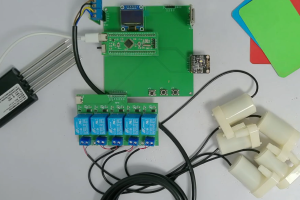设计说明书
总字数:20000+
摘要
随着现代农业向精准化、智能化方向发展,对作物生长过程中的水肥药施用进行精准调控,对于提高资源利用率、减少环境污染、提升作物产量与品质具有重要意义。传统的水肥药管理主要依赖人工经验进行粗放式施用,存在资源浪费严重、施用时机不准确、无法根据土壤与作物状态动态调整等问题,难以满足现代化农业高效、绿色的发展需求。
基于 STM32F103C8T6 单片机的基于物联网的水肥药控制系统(项目编号:mcuclub-dz-740),整合了土壤环境监测模块 ZTS-3002、颜色传感器 TCS3472、OLED 显示屏、按键、WiFi 模块 ESP8266 及继电器(控制水泵、复合肥添加装置、农药喷洒装置等),实现了作物生长过程中水肥药的自动化监测与精准调控。系统核心功能包括:通过 ZTS-3002 实时监测土壤的温度、水分、电导率、PH 值及氮磷钾含量,当水分低于预设最小值时,自动启动水泵加水直至水分高于最大值;当氮磷钾中任意一种含量低于最小值时,自动启动复合肥料添加装置;通过 TCS3472 检测植物叶片颜色,若为绿色则判定生长正常,若为黄色或红色则判定存在病害,分别控制对应继电器喷洒相应农药;支持通过按键启停继电器以手动控制水泵和农药喷洒,设置各参数阈值及控制各执行装置;通过 OLED 显示屏实时显示各项监测数据及设备运行状态;利用 WiFi 模块 ESP8266 将监测数据上传至阿里云平台,再下发至手机端,实现手机端参数设置与各执行装置的远程控制。
该系统的实现,有效提升了水肥药管理的自动化与智能化水平,实现了按需精准施用,减少了资源浪费与环境污染,为现代化农业种植提供了高效、绿色的解决方案,同时为同类农业智能控制设备的研发提供了参考,具有较高的实际应用价值。
关键词:STM32F103C8T6;物联网;水肥药控制;ZTS-3002;TCS3472;ESP8266
ABSTRACT
With the development of modern agriculture towards precision and intelligence, precise regulation of water, fertilizer and pesticide application during crop growth is of great significance for improving resource utilization, reducing environmental pollution, and enhancing crop yield and quality. The traditional management of water, fertilizer and pesticide mainly relies on manual experience for extensive application, which has problems such as serious waste of resources, inaccurate application timing, and inability to dynamically adjust according to soil and crop conditions, making it difficult to meet the needs of efficient and green development of modern agriculture.
The IoT-based water, fertilizer and pesticide control system (Project No.: mcuclub-dz-740) based on the STM32F103C8T6 microcontroller integrates the soil environment monitoring module ZTS-3002, color sensor TCS3472, OLED display, buttons, WiFi module ESP8266 and relays (controlling water pumps, compound fertilizer adding devices, pesticide spraying devices, etc.), realizing automatic monitoring and precise regulation of water, fertilizer and pesticide during crop growth. The core functions of the system include: real-time monitoring of soil temperature, moisture, electrical conductivity, PH value and nitrogen, phosphorus and potassium contents through ZTS-3002; when the moisture is lower than the preset minimum value, the water pump is automatically started to add water until the moisture is higher than the maximum value; when any one of nitrogen, phosphorus and potassium contents is lower than the minimum value, the compound fertilizer adding device is automatically started; detecting the color of plant leaves through TCS3472; if it is green, the growth is judged to be normal; if it is yellow or red, it is judged to be diseased, and the corresponding relays are controlled to spray corresponding pesticides respectively; supporting the start and stop of relays through buttons to manually control water pumps and pesticide spraying, set various parameter thresholds and control various executive devices; real-time display of various monitoring data and equipment operating status through OLED display; uploading monitoring data to Alibaba Cloud platform through WiFi module ESP8266, then distributing to mobile phones, realizing parameter setting and remote control of various executive devices on mobile phones.
The implementation of this system effectively improves the automation and intelligence level of water, fertilizer and pesticide management, realizes on-demand precise application, reduces resource waste and environmental pollution, provides an efficient and green solution for modern agricultural planting, and also provides a reference for the research and development of similar agricultural intelligent control equipment, with high practical application value.
Keywords:STM32F103C8T6; Internet of Things; water, fertilizer and pesticide control; ZTS-3002; TCS3472; ESP8266
目录
第1章 绪论
1.1 研究的目的及意义
1.2 国内外发展情况
1.3 本文主要研究内容
第2章 设计思路与方案论证
2.1 主要元器件选择
2.1.1 主控芯片选择
2.1.2 土壤环境监测模块选择
2.1.3 颜色传感器选择
2.1.4 显示模块选择
2.1.5 按键模块选择
2.1.6 WiFi 模块选择
2.2整体设计方案
第 3 章 硬件设计
3.1 主控电路模块
3.2 土壤环境监测模块电路
3.3 颜色传感器电路
3.4 显示模块电路
3.5 按键模块电路
3.6 WiFi 模块电路
3.7 执行设备驱动电路
第4章 系统程序设计
4.1 编程软件介绍
4.2 系统主流程设计
4.3 OLED显示子流程设计
4.4 独立按键子流程设计
4.5 ADC模数转换子流程设计
4.6 颜色模块子流程设计
4.7 土壤环境检测模块子流程设计
4.8 WiFi模块子流程设计
第 5 章 实物测试
5.1 整体实物测试
5.2 土壤环境监测模块功能测试
5.3 颜色传感器功能测试
5.4 显示模块功能测试
5.5 按键模块功能测试
5.6 WiFi 模块功能测试
5.7 执行设备功能测试
5.8 喷农药控制功能测试
第6章 总结与展望
6.1 总结
6.2 展望
致谢
参考文献
附录
附录一:原理图
附录二:PCB
附录三:主程序
购买后可查看具体内容!

